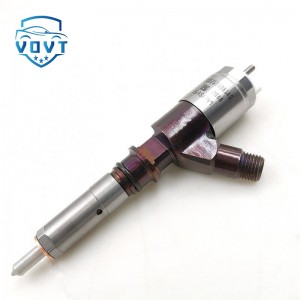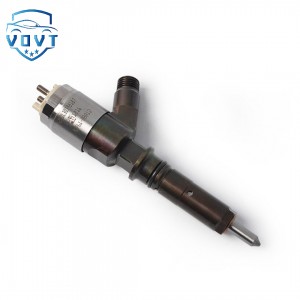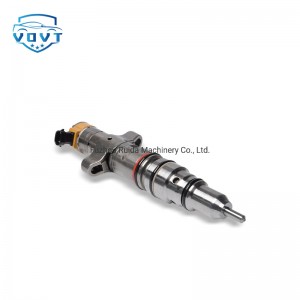New High Quality Diesel Injector 212-3468 10R-1258 212-3476 223-5328 10R-1003 236-4086 For CAT C12
Products Description
| Reference. Codes | C12 |
| Application | C12 |
| MOQ | 4PCS |
| Certification | ISO9001 |
| Place of Origin | China |
| Packaging | Neutral packing |
| Quality Control | 100% tested before shipment |
| Lead time | 7~10 working days |
| Payment | T/T, L/C, Paypal, Western Union, MoneyGram or as your requirement |
Study on the Characteristics of Diesel Engine Injector
Diesel engines, with their high torque and low fuel consumption, occupy an important position in the fields of transportation, industrial machinery, and ship power. As the core executive component of the diesel engine fuel injection system, the performance of the injector directly determines the fuel atomization quality, combustion efficiency, and pollutant emission level. This paper focuses on the key characteristics of diesel engine injectors and conducts a systematic study from the structural principle, spray characteristics, influencing factors, and optimization directions, aiming to provide theoretical support for the design, manufacture, and application of injectors.
Structure and working principle of diesel engine injectors
Core structure
Diesel engine injectors are mainly composed of electromagnetic coils, needle valve components, spray holes, pressure chambers, etc. (as shown in Figure 1). Among them, the matching accuracy of the needle valve and the valve seat is as high as micron level, the spray hole diameter is usually 0.1-0.5mm, and the internal surface roughness is controlled at Ra≤0.2μm to ensure the stability of fuel flow.
Typical structure of diesel engine fuel injector
Working principle
The fuel injector controls the opening and closing of the needle valve by energizing the electromagnetic coil - de-energizing to achieve precise fuel injection:
Power-on state: ECU sends an electrical signal to the electromagnetic coil, generating electromagnetic force to suck up the needle valve, and high-pressure fuel (100-200MPa) is ejected from the spray hole at high speed to form mist particles.
Power-off state: The electromagnetic force disappears, the needle valve is closed under the action of the return spring, and the fuel injection stops.
Dynamic adjustment: The injection pulse width (0.5-20ms) and injection pressure are adjusted in real time according to the engine working conditions (speed, load, temperature). For example, the injection amount under full load conditions can be increased by 5-8 times compared with the idle condition.
Key indicators of fuel injector spray characteristics
Atomization fineness
Measured by ** Sauter mean diameter (SMD)**, the ideal droplet diameter is 20-50μm. The smaller the SMD, the larger the contact area between the fuel and the air, and the higher the combustion efficiency. Studies have shown that when SMD is reduced from 80μm to 30μm, the combustion speed increases by 60% and the nitrogen oxide (NOx) emissions decrease by 25%.
Spray penetration distance
Refers to the axial movement distance of the spray front end in a certain period of time, which needs to match the depth of the combustion chamber. For example, heavy truck diesel engines require a spray penetration distance of 150-200mm to cover the spacious combustion chamber space; while small diesel engines need to be controlled at 50-100mm to avoid fuel spraying on the cylinder wall to produce carbon deposits.
Spray cone angle
Reflects the degree of spray diffusion, usually 60°-150°. Large cone angle spray is suitable for shallow basin combustion chambers, and small cone angle spray is more suitable for deep bowl combustion chambers. Uneven spray cone angles will lead to inconsistent combustion in each cylinder, causing engine vibration and worsening emissions.
Key factors affecting injector characteristics
Injection pressure
Increasing pressure can significantly improve atomization effect: when the pressure increases from 100MPa to 200MPa, SMD decreases from 60μm to 35μm, and the spray penetration distance increases by 30%. However, excessive pressure (>250MPa) will aggravate the wear of the nozzle hole and shorten the life of the injector.
Nozzle hole structure parameters
Aperture: Reducing the aperture (such as from 0.3mm to 0.15mm) can increase the injection speed, but it is easily blocked by fuel impurities.
Aperture aspect ratio: Increasing the aspect ratio (such as from 2:1 to 5:1) can stabilize the fuel flow and reduce cavitation-induced spray splitting, but it will increase the flow resistance.
Physical properties of fuel
Fuel viscosity and surface tension directly affect the atomization performance. For example, when the viscosity of diesel increases from 3mm²/s to 5mm²/s, the SMD increases by 20%. It is necessary to heat the fuel (such as preheating to 50-60℃) to reduce the viscosity and improve atomization.
Cavitation phenomenon
Cavitation refers to the formation of bubbles due to a sudden drop in pressure when the fuel flows through the nozzle. When the bubbles burst, energy is released to promote atomization, but excessive cavitation will cause erosion on the nozzle surface. Studies have shown that the degree of cavitation is closely related to the fillet radius of the nozzle entrance. When the fillet radius increases from 0.05mm to 0.2mm, the cavitation intensity decreases by 40% and the wear rate decreases by 50%.
Injector characteristic optimization technology
Structural optimization
Multi-hole nozzle design: adopt a 6-10-hole nozzle layout, combined with different spray angles (such as 15°/30°/45°), to achieve uniform fuel distribution in the combustion chamber space.
Variable cross-section spray hole: adopts zoom-type spray hole (contracts first and then expands), uses the Venturi effect to enhance cavitation, and improves the atomization effect while maintaining low wear.
Material and process upgrade
Wear-resistant material: The spray hole adopts silicon nitride ceramic (hardness up to HV1500) or diamond coating (thickness 2-5μm), and the corrosion resistance is improved by more than 3 times.
Precision machining: through laser drilling (aperture tolerance ±0.002mm) and magnetorheological polishing (roughness Ra≤0.1μm), the inner surface of the spray hole is ensured to be smooth and the fuel turbulence is reduced.
Intelligent control technology
Multi-stage injection strategy: adopts "pre-injection-main injection-post-injection" segmented control, pre-injection reduces combustion noise, post-injection promotes soot oxidation, and NOx and PM emissions can be reduced by 15%-20% at the same time.
Real-time feedback system: The injector with integrated pressure sensor can monitor the injection pressure fluctuation in real time, and the ECU dynamically adjusts the injection pulse width according to the feedback signal, and the control accuracy is improved to ±1%.
Test verification and application cases
Spray characteristics test
On the high-pressure common rail test bench, a 6-hole injector was tested (injection pressure 180MPa, injection pulse width 5ms), and the results showed that:
The spray SMD was 42μm, meeting the requirements of the National VI emission for atomization fineness;
The deviation of the spray cone angle of each hole was less than 3°, and the penetration distance consistency error was ≤5%, ensuring the combustion uniformity of each cylinder.
Application effect
After a heavy truck diesel engine was equipped with an optimized injector, the measured data showed that:
The fuel consumption rate dropped from 215g/kWh to 200g/kWh, and the fuel saving rate was 7%;
PM emissions dropped from 0.03g/kWh to 0.015g/kWh, and NOx emissions dropped from 3.5g/kWh to 2.8g/kWh, meeting the EU Stage V emission standards.
Conclusion and Prospect
The research on the characteristics of diesel engine injectors is an interdisciplinary project integrating fluid mechanics, materials science and control engineering. At present, through structural optimization, material upgrades and intelligent control, fuel injectors have achieved a leap from "passive execution" to "active perception". In the future, with the application of ultra-high pressure injection (above 300MPa), nanomaterial coatings and AI algorithms, fuel injectors will further improve the accuracy and reliability of fuel atomization, laying a solid foundation for the development of diesel engines towards high efficiency and low carbonization.





















